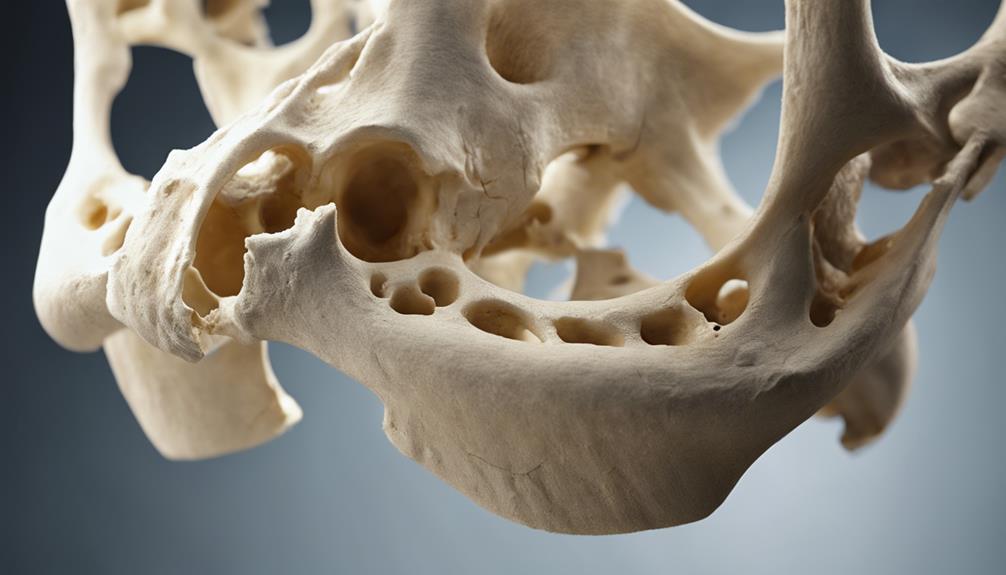Have you ever considered if your ongoing tiredness could indicate osteoporosis?
While the direct link between osteoporosis and tiredness may not be crystal clear, there are intriguing connections worth exploring.
Factors like vitamin deficiencies or medication side effects could play a role in sapping your energy levels.
Understanding these nuances and seeking tailored advice could shed light on managing fatigue effectively within the realm of osteoporosis.
Understanding Osteoporosis-Related Fatigue
In our exploration of osteoporosis-related fatigue, it's crucial to understand the intricate connection between bone health and energy levels. When bone health deteriorates, as seen in osteoporosis, it can contribute to feelings of fatigue. One significant factor in this relationship is vitamin D deficiency. Vitamin D plays a vital role in maintaining bone health by aiding in the absorption of calcium, which is essential for strong bones. When levels of vitamin D are low, it can lead to weakened bones, increasing the risk of osteoporosis, and subsequently, fatigue.
Individuals with osteoporosis may experience fatigue not only due to the condition itself but also because of the medications used to manage it. Some osteoporosis medications, like Prolia and Forteo, list fatigue as a potential side effect. Additionally, nutritional imbalances, such as vitamin B12 deficiency, can further contribute to feelings of exhaustion in individuals battling osteoporosis. Therefore, addressing bone health issues, ensuring adequate intake of essential nutrients like vitamin D, and monitoring medication side effects are crucial steps in managing fatigue associated with osteoporosis.
Impact of Osteoporosis on Energy Levels

Osteoporosis can have a significant impact on our energy levels due to factors like pain, fractures, and medication side effects. Chronic pain and reduced mobility stemming from fractures can lead to increased fatigue levels, while certain osteoporosis medications may disrupt sleep patterns and contribute to feelings of tiredness.
Energy and Bone Health
Fatigue related to osteoporosis can significantly impact one's energy levels, affecting daily activities and overall well-being. When bone density decreases due to osteoporosis, it can lead to feelings of tiredness and exhaustion. This, in turn, can make it challenging to engage in physical activities and maintain a vibrant lifestyle. Here is a table summarizing key factors that can influence energy levels in individuals with osteoporosis:
| Factors | Influence on Energy Levels |
|---|---|
| Vitamin D Deficiency | Muscle weakness and exhaustion |
| Medication Side Effects | Fatigue as a side effect |
| Chronic Diseases | Low bone density and fatigue |
| Nutritional Imbalances | Tiredness and low energy levels |
Understanding these factors can help in managing fatigue and promoting better energy levels for individuals with osteoporosis.
Fatigue and Osteoporosis
Experiencing fatigue can significantly impact the daily lives of individuals with osteoporosis, affecting their energy levels and overall well-being. Fatigue in osteoporosis can stem from various sources like vitamin D deficiency, medication side effects, and chronic pain associated with the condition.
Medications commonly used for treating osteoporosis, such as Prolia, Forteo, and Tymlos, may sometimes lead to fatigue as a side effect, adding to the challenges faced by individuals managing the condition. Nutritional imbalances, including deficiencies in vitamin D and B12, can further contribute to exhaustion in those with osteoporosis.
Addressing these factors and ensuring adequate nutrition, alongside proper management of medication side effects, are crucial steps in managing fatigue and enhancing energy levels in individuals living with osteoporosis.
Lifestyle Impact on Energy
Understanding how lifestyle choices impact our energy levels while living with osteoporosis is essential for maintaining overall well-being and quality of life. Fatigue in osteoporosis can be influenced by factors such as vitamin D deficiency, medication side effects, and the toll of pain on daily activities. Nutritional imbalances, lack of exercise, and poor sleep quality can exacerbate this fatigue.
Managing energy levels with osteoporosis involves identifying and addressing these underlying causes, incorporating energy-boosting activities into daily routines, and seeking guidance from healthcare providers. Lifestyle modifications like following a balanced diet, engaging in regular exercise, and ensuring adequate rest play a crucial role in combating fatigue associated with osteoporosis.
Fatigue as a Symptom of Osteoporosis

When managing osteoporosis, it's essential to recognize that fatigue can be a common symptom that impacts our daily lives. Understanding the relationship between bone health and energy levels is crucial in navigating the challenges of osteoporosis.
Exploring various factors like medications, chronic diseases, nutrition, lifestyle choices, and support systems can help us address and manage fatigue effectively.
Fatigue and Bone Health
Struggling with fatigue alongside osteoporosis can stem from various factors, including medication side effects and nutritional deficiencies.
Medications like Prolia and Forteo, commonly used to treat osteoporosis, may cause fatigue as a side effect. Nutritional imbalances, such as vitamin D deficiency, can contribute to exhaustion in individuals with osteoporosis. These deficiencies weaken bones and lead to increased fatigue.
Lifestyle choices, like lack of exercise and poor eating habits, can exacerbate fatigue in those with osteoporosis. It's crucial to consult healthcare providers to address fatigue related to osteoporosis and develop appropriate management strategies.
Energy Levels and Osteoporosis
Fatigue can often be a significant symptom of osteoporosis, influenced by various factors like medication side effects and nutritional deficiencies. Certain osteoporosis medications, including Prolia, Forteo, and Tymlos, may contribute to fatigue, impacting energy levels.
Chronic diseases like Cushings disease, diabetes, and stress can also lead to low bone density, fatigue, and affect overall energy levels in individuals with osteoporosis. Nutritional factors such as vitamin D deficiency and imbalances in nutrients like vitamin B12 can further worsen fatigue in those with osteoporosis.
Managing fatigue in osteoporosis may involve lifestyle changes, incorporating exercise to boost energy levels, and seeking guidance from healthcare providers for personalized advice on nutrition and fatigue management.
Managing Fatigue With Osteoporosis

Managing fatigue while dealing with osteoporosis can be effectively approached through lifestyle modifications and seeking support from healthcare professionals and support groups. It's essential to address factors like medication side effects and nutritional imbalances that can worsen fatigue in individuals with osteoporosis. Medications such as Prolia, Forteo, and Tymlos, commonly used for treating osteoporosis, may contribute to fatigue as a side effect. Incorporating proper nutrition, regular exercise, and ensuring adequate sleep are crucial lifestyle modifications that can help manage fatigue associated with osteoporosis. Additionally, seeking support from healthcare professionals, joining support groups, and exploring complementary therapies can provide valuable assistance in coping with fatigue while living with osteoporosis.
| Strategies for Managing Fatigue with Osteoporosis | Benefits |
|---|---|
| Proper nutrition | Increased energy levels |
| Regular exercise | Improved overall health |
| Adequate sleep | Enhanced well-being |
| Seeking support from healthcare professionals | Tailored guidance and treatment |
| Joining support groups | Emotional support and shared experiences |
Link Between Bone Health and Tiredness

When it comes to understanding the link between bone health and tiredness, it becomes evident that fatigue can significantly impact daily activities for individuals with osteoporosis.
Factors such as bone density and vitamin D deficiency play a crucial role in contributing to the overall energy levels of those affected by this condition.
Recognizing how bone health influences tiredness can be pivotal in managing symptoms and improving quality of life for individuals facing osteoporosis.
Fatigue and Bone Density
With a direct impact on our energy levels and overall vitality, the intricate relationship between bone density and fatigue in individuals with osteoporosis unveils a crucial connection worth exploring further.
Here are some key points to consider:
- Osteoporosis can contribute to fatigue through factors like medication side effects and the impact of low bone density on overall health.
- Low bone density directly affects energy levels, potentially leading to increased tiredness in individuals with osteoporosis.
- Medications such as Prolia, Forteo, and Tymlos used to manage osteoporosis can also influence fatigue levels.
- Proper management of osteoporosis, including treatment, nutrition, and lifestyle adjustments, plays a vital role in reducing fatigue and enhancing quality of life.
Understanding these connections can help individuals with osteoporosis address fatigue effectively and improve their overall well-being.
Vitamin D Deficiency
Understanding the impact of vitamin D deficiency on bone health and tiredness is crucial for individuals managing osteoporosis. Vitamin D deficiency, prevalent in osteoporosis patients, can lead to fatigue, muscle weakness, and bone pain.
Low levels of vitamin D are closely linked to decreased energy levels and overall tiredness. This vital nutrient plays a significant role in maintaining bone health and energy levels in the body. Inadequate vitamin D levels can exacerbate the fatigue experienced by those with osteoporosis.
Impact on Daily Activities
Chronic pain, reduced mobility, and fractures associated with osteoporosis can significantly impact daily activities, contributing to feelings of tiredness and fatigue. When dealing with osteoporosis, the strain on the body from constant healing and bone maintenance can lead to exhaustion. Factors like disrupted sleep patterns due to pain and discomfort can exacerbate feelings of fatigue.
The following list highlights how osteoporosis can affect daily life and contribute to tiredness:
- Managing tasks with pain and limitations can be draining.
- Coping with the emotional challenges of osteoporosis can add to fatigue.
- Constant healing from fractures demands extra energy.
- Disrupted sleep due to pain can lead to increased tiredness.
Understanding these impacts is crucial in managing osteoporosis-related fatigue effectively.
Strategies to Combat Fatigue in Osteoporosis

Strategies to combat fatigue in osteoporosis can significantly improve daily quality of life for individuals dealing with this condition. Fatigue in osteoporosis can be exacerbated by factors such as vitamin D deficiency, medication side effects, and nutritional imbalances. One effective way to address fatigue is by ensuring adequate intake of vitamin D through supplements or foods rich in this nutrient. Additionally, joining a support group can provide emotional support and practical tips for managing fatigue.
Incorporating lifestyle modifications, such as engaging in regular exercise tailored to osteoporosis patients, can help combat fatigue and improve overall energy levels. It's crucial to address any underlying chronic conditions like Cushings disease or diabetes, which may contribute to fatigue in individuals with osteoporosis. Moreover, managing stress levels through relaxation techniques or mindfulness practices can also play a significant role in combating fatigue.
Osteoporosis Medications and Fatigue

Many osteoporosis medications, including Prolia, Forteo, and Tymlos, can induce fatigue as a common side effect. This can be challenging for individuals managing osteoporosis, as fatigue can significantly impact daily life. Understanding the effects of these medications is crucial for effectively managing the condition.
- Medication Side Effects: Osteoporosis medications like Prolia, Forteo, and Tymlos are known to cause fatigue in some individuals.
- Other Medications: Besides osteoporosis medications, certain heart, antidepressant, and decongestant medications may also contribute to fatigue.
- Underlying Chronic Conditions: Chronic diseases such as Cushings disease, diabetes, and stress can exacerbate fatigue in osteoporosis patients.
- Nutritional Factors: Nutritional imbalances like vitamin D deficiency and lack of vitamin B12 can lead to exhaustion in those with osteoporosis.
Being aware of these factors and discussing any concerns with a healthcare provider can help in managing fatigue associated with osteoporosis and its medications effectively.
Addressing Fatigue Through Lifestyle Changes

Addressing fatigue through lifestyle changes is essential for individuals managing osteoporosis and its associated challenges. Fatigue in osteoporosis can be influenced by factors like vitamin deficiencies, medication side effects, and underlying health conditions. To combat this fatigue, incorporating lifestyle modifications is crucial.
Nutritional imbalances, lack of exercise, and poor sleep quality can worsen fatigue levels. Therefore, focusing on maintaining a balanced diet rich in essential nutrients, engaging in regular physical activity to strengthen bones, and improving sleep quality can help alleviate fatigue symptoms. Additionally, addressing vitamin deficiencies through dietary adjustments or supplements can play a significant role in boosting energy levels.
Seeking support from healthcare professionals, joining support groups, and following guidance tailored to managing fatigue in osteoporosis can provide valuable insights and strategies. By making these lifestyle changes, individuals with osteoporosis can take proactive steps towards managing fatigue and improving their overall well-being.
Coping With Fatigue and Bone Health

Fatigue management in individuals with osteoporosis requires a holistic approach that considers both bone health and overall well-being. When coping with fatigue and bone health, it's essential to address the following key points:
- Vitamin Deficiencies: Ensuring adequate intake of essential vitamins like D can help combat fatigue and support bone health.
- Nutritional Balance: Maintaining a well-rounded diet rich in calcium and other nutrients is crucial for energy levels and bone strength.
- Exercise Routine: Engaging in regular physical activity, such as weight-bearing exercises, can boost energy and promote bone density.
- Stress Management: Finding ways to reduce stress levels through relaxation techniques or mindfulness practices can improve both bone health and combat fatigue.
Tips for Boosting Energy With Osteoporosis

Boosting energy levels while managing osteoporosis requires a multifaceted approach that encompasses nutrition, exercise, and medical guidance. When dealing with fatigue associated with osteoporosis, it's crucial to focus on lifestyle adjustments that can positively impact your energy levels. Here are some practical tips to help you combat fatigue and boost your energy:
| Nutrition | Exercise | Medical Guidance |
|---|---|---|
| Ensure a diet rich in calcium, vitamin D, and other nutrients essential for bone health. | Engage in weight-bearing exercises like walking, dancing, or strength training to strengthen bones and improve overall energy levels. | Consult with your healthcare provider to assess your medications' potential impact on fatigue and explore alternative options if needed. |
| Stay hydrated throughout the day to support bodily functions and prevent fatigue. | Practice balance exercises to reduce the risk of falls and fractures, which can further contribute to fatigue. | Get regular check-ups to monitor bone health and address any underlying conditions that may be causing fatigue. |
| Limit caffeine and sugar intake, as they can lead to energy crashes and disrupt sleep patterns. | Incorporate flexibility exercises such as yoga or tai chi to improve posture, reduce stiffness, and enhance energy levels. | Consider seeking guidance from a nutritionist or dietitian to optimize your diet for better energy levels and bone health. |
Seeking Support for Osteoporosis-Related Fatigue

When managing osteoporosis-related fatigue, seeking support from healthcare professionals and joining support groups can provide valuable guidance and emotional assistance. Dealing with fatigue from chronic diseases, medication side effects, and other factors can be overwhelming, but you aren't alone in this journey. Here are some ways support can help:
- Expert Advice: Healthcare professionals can offer tailored solutions to manage fatigue, such as adjusting medications or recommending specific lifestyle changes.
- Emotional Support: Support groups provide a safe space to share experiences, feelings, and coping strategies with others facing similar challenges.
- Education: Learning about the causes of fatigue related to osteoporosis can empower you to make informed decisions about your health and well-being.
- Practical Tips: Support networks can offer practical tips on managing daily activities, improving sleep quality, and boosting energy levels.
Recognizing the Signs of Fatigue in Osteoporosis

In individuals managing osteoporosis, recognizing the signs of fatigue can be crucial for understanding the impact of the condition on daily energy levels. Fatigue in osteoporosis can stem from various factors such as vitamin D deficiency, medication side effects, and chronic pain.
Vitamin D deficiency, often seen in individuals with osteoporosis, can contribute significantly to feelings of fatigue. Additionally, certain medications commonly used to treat osteoporosis, like Prolia, Forteo, and Tymlos, may have side effects that exacerbate fatigue. It's essential to be aware of these possibilities when experiencing fatigue alongside osteoporosis symptoms.
Moreover, conditions that are linked to osteoporosis, such as Cushings disease and diabetes, can also play a role in increasing fatigue levels. Nutritional deficiencies, particularly low levels of vitamin D and vitamin B12, can further impact fatigue in individuals managing osteoporosis. Recognizing these signs can aid in better understanding and managing fatigue levels associated with osteoporosis.
Improving Quality of Life Despite Osteoporosis-Related Fatigue

Understanding how to effectively manage osteoporosis-related fatigue is crucial for improving overall quality of life despite the challenges it presents. When dealing with fatigue in osteoporosis, it's essential to take proactive steps to enhance energy levels and well-being.
Here are four key strategies to help you navigate through osteoporosis-related fatigue:
- Identify Contributing Factors: Determine the root causes of your fatigue, such as vitamin deficiencies or medication side effects, to address them effectively.
- Prioritize Sleep Quality: Improve sleep hygiene to combat discomfort from osteoporosis pain, promoting better rest and reducing fatigue levels.
- Optimize Nutrition: Ensure a balanced diet rich in key nutrients like vitamin B12 to support overall energy and combat fatigue associated with osteoporosis.
- Incorporate Exercise: Regular physical activity can boost energy levels, strengthen bones, and alleviate fatigue, contributing to an improved quality of life despite osteoporosis-related challenges.
Frequently Asked Questions
How Does Your Body Feel When You Have Osteoporosis?
When we've osteoporosis, our bodies may experience pain, limited mobility, and fractures, affecting our daily lives. These challenges can lead to feelings of discomfort and decreased energy levels.
Managing osteoporosis effectively is crucial to alleviate these symptoms and improve overall well-being. By taking steps to address pain, improve bone health, and stay active, we can enhance our quality of life and combat fatigue associated with this condition.
What Are the Signs of Osteoporosis Getting Worse?
As osteoporosis progresses, signs of worsening may include increased fracture frequency, heightened pain levels, and reduced mobility. These indicators signal a decline in bone health and require close monitoring.
Regular bone density scans, pain management strategies, and lifestyle modifications become paramount. Neglecting these signals can lead to further complications and decreased quality of life.
It's crucial to address these signs promptly to maintain our well-being and independence.
What Should You NOt Do if You Have Osteoporosis?
When managing osteoporosis, it's essential to avoid high-impact activities. Prioritize good posture, quit smoking, limit alcohol intake, and take prescribed medications consistently. Prolonged inactivity should also be steered clear of to prevent muscle weakness and further bone loss.
These practices help maintain bone strength and reduce the risk of fractures. It's vital to adhere to these guidelines to safeguard our bone health and overall well-being when living with osteoporosis.
What Helps Osteoporosis From Getting Worse?
To prevent osteoporosis from worsening, we focus on strategies like:
- Weight-bearing exercises
- Calcium and vitamin D intake
- Prescribed medications
- Fall prevention
These measures are vital in maintaining bone health and reducing fracture risk.
Lifestyle changes such as:
- Quitting smoking
- Moderating alcohol
- Managing weight
are also key. By following these recommendations, we can help manage osteoporosis effectively and improve quality of life.
Conclusion
As we navigate the challenges of osteoporosis-related fatigue, it's crucial to address underlying factors and seek support for optimal management.
Did you know that studies have shown that individuals with osteoporosis are more likely to experience fatigue compared to those without the condition?
By prioritizing bone health and implementing energy-boosting strategies, we can enhance our quality of life despite the impact of osteoporosis on our energy levels.
Stay informed, stay proactive, and take care of yourself.










